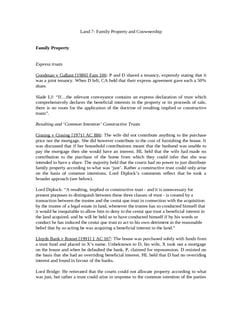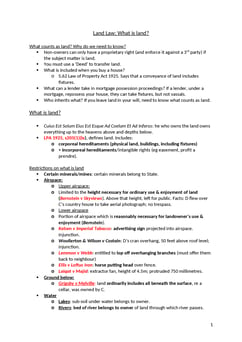Re Ellenborough Park [1956] Ch 131
Judgement for the case Re Ellenborough Park
Table Of Contents
KEY POINTS
-
Lord Evershed MR established that for there to be an easement, the following requisites must concur:
There must be a dominant and a servient tenement;
An easement must "accommodate" the dominant tenement;
Dominant and servient owners must be different persons; and
A right over land cannot amount to an easement unless it is capable of forming the subject matter of a grant.
FACTS
The owner of Ellenborough Park made the decision to subdivide the piece of land and to set aside a section for the construction of a private park, which would serve as a shared amenity for the owners of the estate's building plots.
The intention was to grant the buyers of the lots close by the right to use the park for recreational activities in exchange for a contribution to the park's upkeep expenditures. For the benefit of these lot buyers, the park was regarded as a shared asset.
The park was commandeered by the War Office for military purposes during World War II. As a result, the War Office paid damages for the park's use throughout the war as well as additional sums for wear and tear or other losses brought on by the requisition.
After the war and several changes among the lot owners, a dispute arose regarding the payment made by the War Office for using the park. The park's trustees wished to distinguish these compensation payments from the money set aside for routine purchases and bills associated with maintaining the park. In addition, concerns were raised about the rights of the owners of the nearby lots to use the park in exchange for payment of their maintenance fees.
JUDGEMENT
The owners of the disputed properties indeed enjoy an easement over Ellenborough Park.
COMMENTARY
Re Ellenborough Park is a seminal case in property law that clarified and expanded the principles surrounding the enforceability of restrictive covenants.
ORIGINAL ANALYSIS
The land around Ellenborough Park was sold for building. Each property owner was granted a right to use the park, subject to covenanting to pay a contribution towards its upkeep. In due course the park was sold, and the new owners wanted to build on it.
The Court of Appeal held that the right to use the park was an easement, and was binding on the new owners.
-
The formula for an easement is the formulation of an easement is:
There must be a dominant and a servient tenement;
An easement must accommodate the dominant tenement;
The dominant and servient owners must be different persons;
A right over land cannot amount to an easement unless it is capable of forming the subject matter of a grant. (Evershed MR).
For Further Study on Re Ellenborough Park

Land Law notes fully updated for recent exams at Oxford and Cambridge. ...
Need instant answers? Our AI exam tutor is here to help.
Ask questions 🙋 Get answers 📔 It's simple 👁️👄👁️
Our AI is educated by the highest scoring students across all subjects and schools. Join hundreds of your peers today.
Get StartedSimilar Cases
Related Product Samples
These product samples contain the same concepts we cover in this case.
| Land Law | Easements Notes (11 pages) |
| GDL Land Law | Easements Notes (5 pages) |
| Land Law | Easements Notes (48 pages) |
| GDL Land Law | Easements 1 Notes (12 pages) |

 Since 2010, Oxbridge Notes has been a trusted education marketplace, supplying high-quality materials from top achievers at universities like Oxford, Cambridge, LSE, Harvard, and Yale.
Since 2010, Oxbridge Notes has been a trusted education marketplace, supplying high-quality materials from top achievers at universities like Oxford, Cambridge, LSE, Harvard, and Yale.